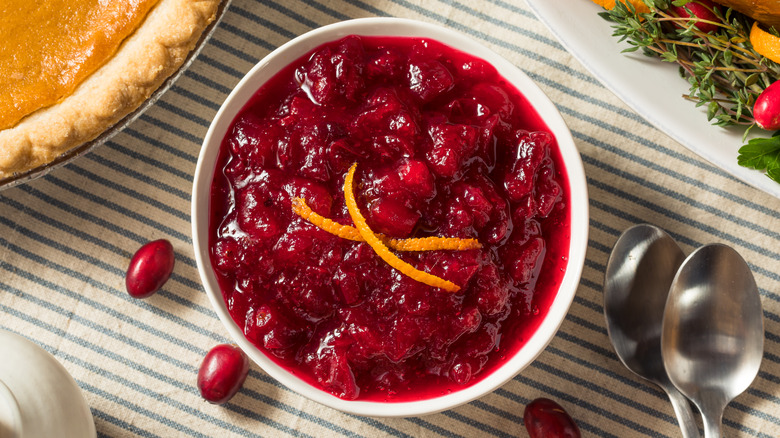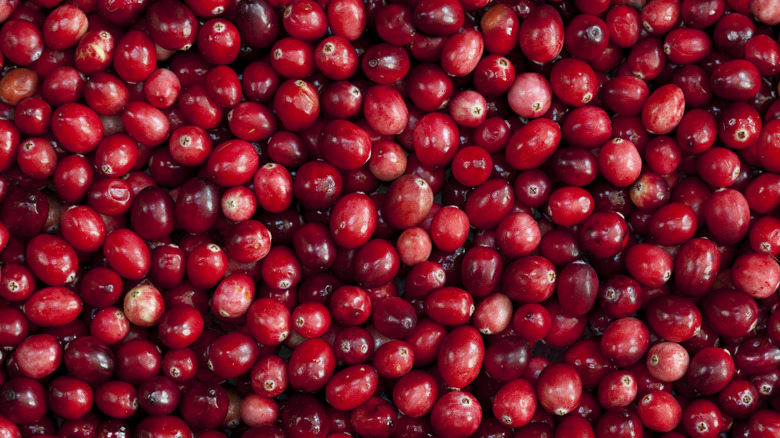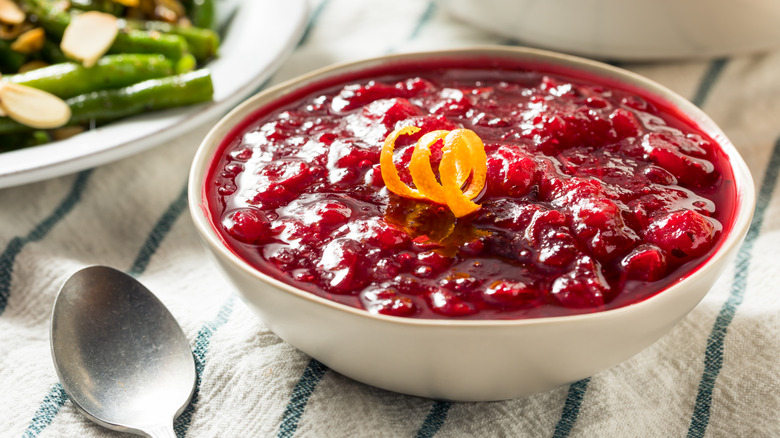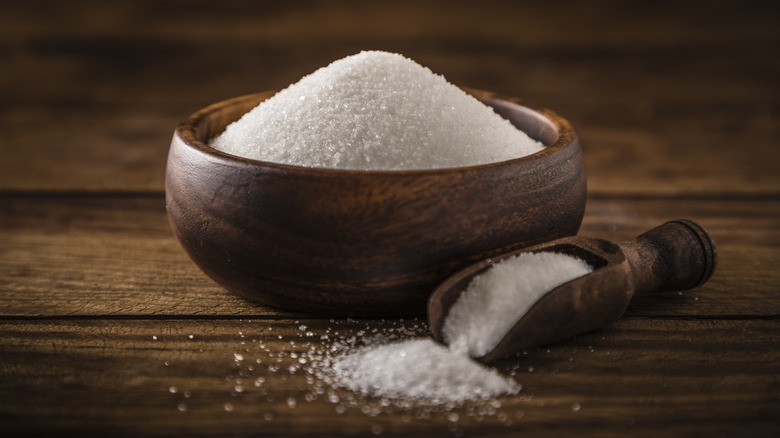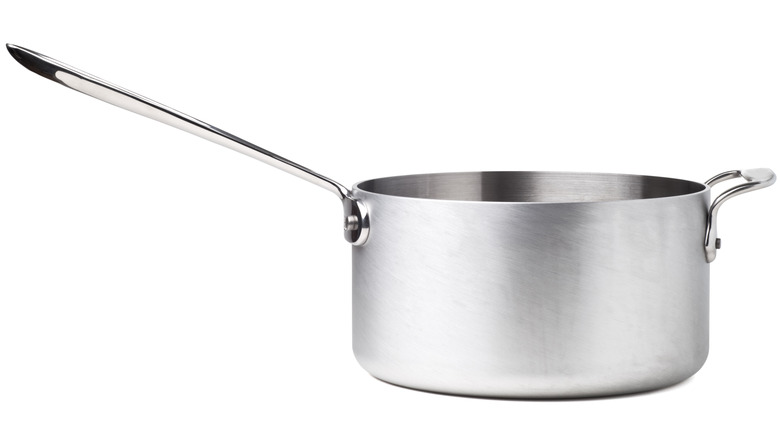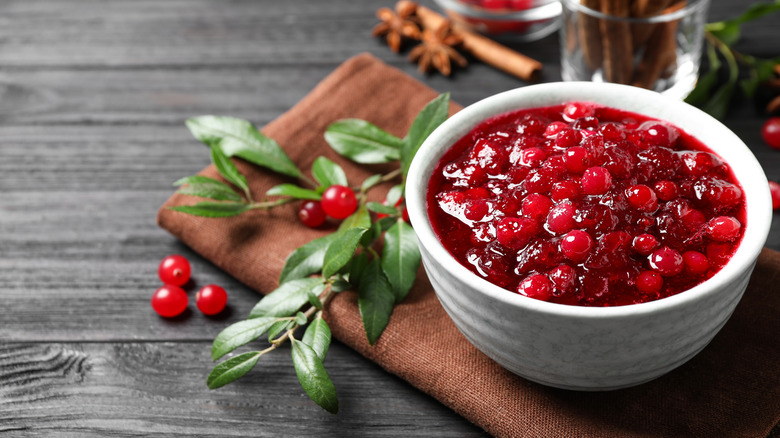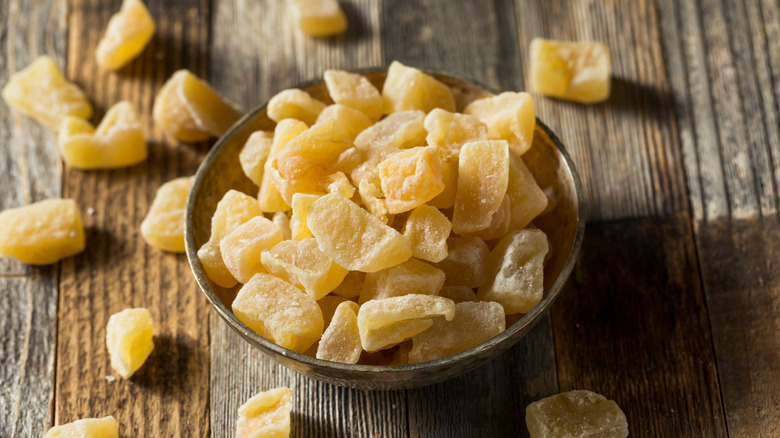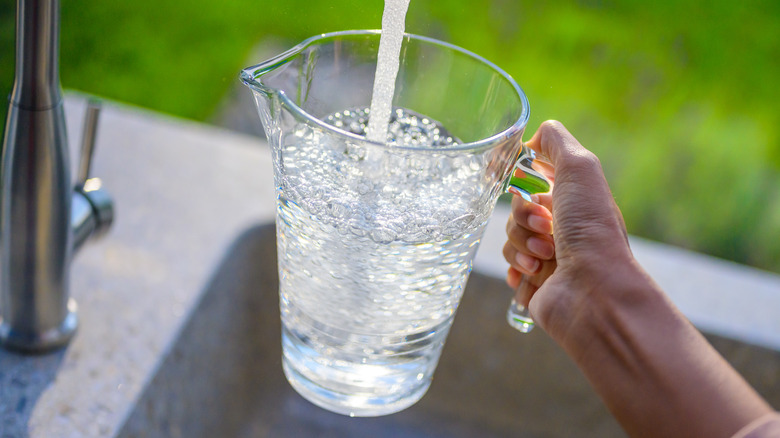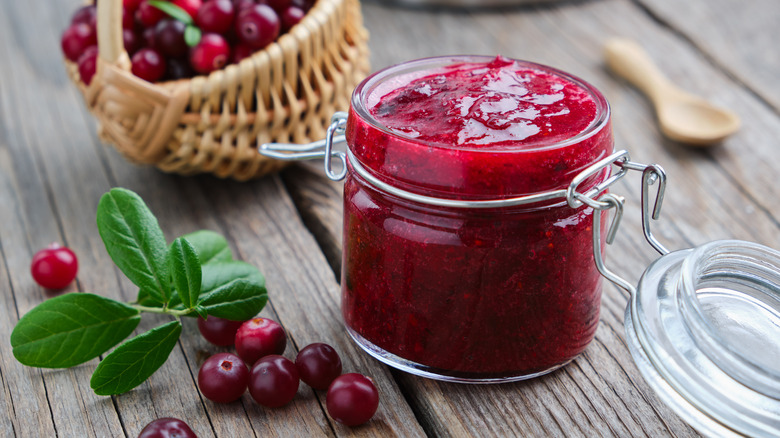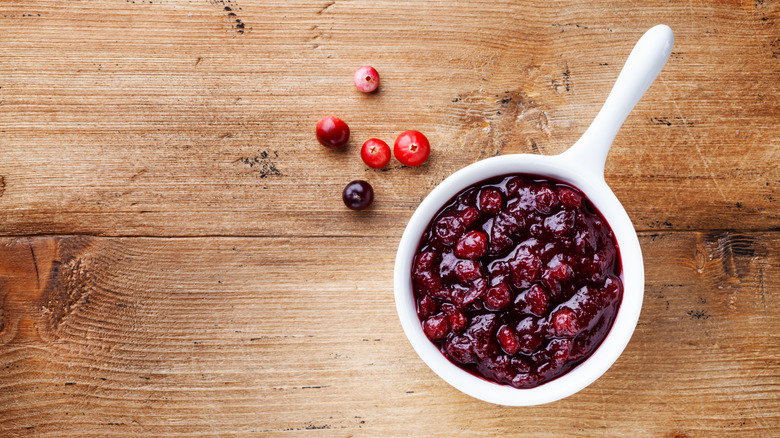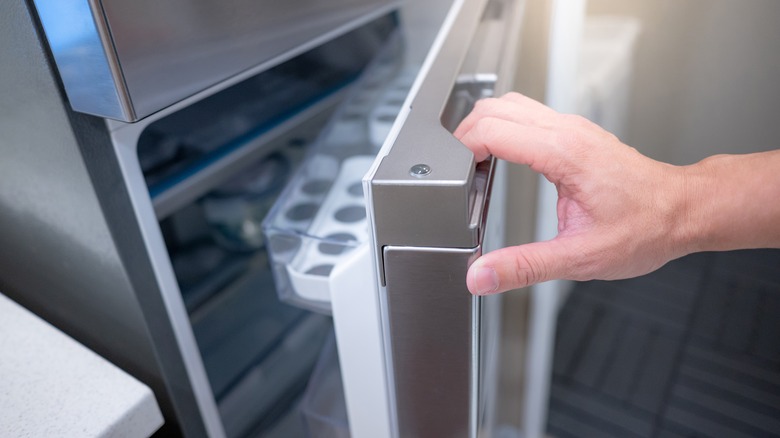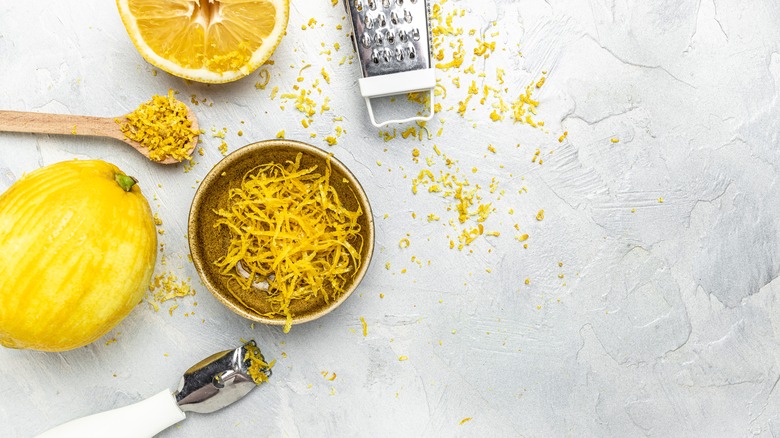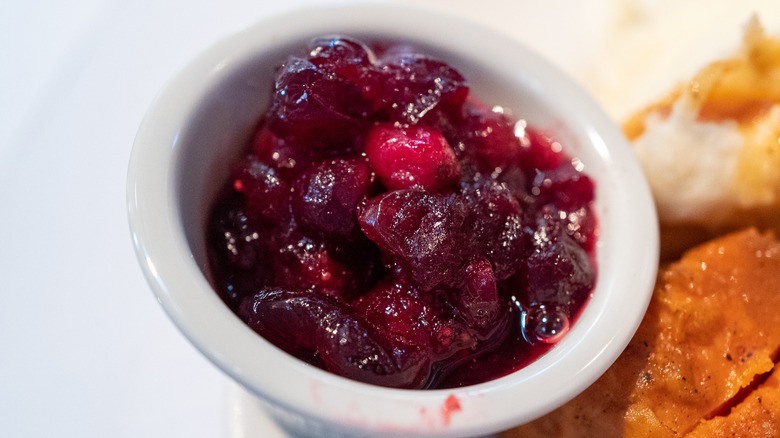14 Mistakes You Need To Avoid With Cranberry Sauce
A holiday meal just isn't complete without cranberry sauce. The classic side dish is the ultimate way to add a pop of sweetness and tang to an otherwise savory Thanksgiving or Christmas dinner, with the sharpness of the cranberries and sugar both heightening the taste of your meat and gravy and working as a palette cleanser. Each year, Americans go through over five million gallons of cranberry sauce, with six out of 10 individuals stating that it's completely indispensable to their holiday table, according to numbers released by Ocean Spray. Of the millions of folks who opt to serve cranberry sauce, over three quarters of them avoid making it, preferring instead to buy it in a can.
Now, getting canned cranberry sauce is all well and good, but making it yourself allows you to construct a bespoke condiment with the exact levels of sweetness, spice, and thickness that you desire. You'll only nail it, though, if you avoid some typical mistakes. Cranberry sauce can be surprisingly difficult to get right, and way too many of them end up being too tart, too thin, or too flavorless. The sauce can also be prone to ending up a little one-note, both in terms of flavor and texture. Keeping these key errors in mind can help you steer clear of these issues and make the best cranberry sauce of your life.
1. Using cranberries that aren't ripe
Cranberry sauce starts with cranberries — we know, we were shocked too! — and if you begin with the wrong type, your sauce will inevitably suffer. The most common issue that people face when buying cranberries is picking ones that haven't ripened sufficiently. As these berries are bought less frequently than other types of fruit, it can be difficult to discern exactly when they're ready, and this can lead to a bitter cranberry sauce that doesn't break down enough or doesn't have that ruby red color.
When ripe, cranberries will have a slight give when you squeeze them, but will still feel firm and plump. They will also have a bright red, consistent color, without any whiteness or discoloration, which can indicate that they haven't ripened sufficiently. If you're buying loose cranberries, one of the best ways to check if they're ripe enough is to drop one on a hard surface. If it sounds hollow when it makes contact, it's probably ready to cook.
Luckily, you don't have to go to the store the day you're making your sauce to find fresh cranberries. These berries keep in the fridge for up to two months and will retain their firmness and flavor, so it's fine to buy them a little in advance.
2. Adding in too much sugar
The best cranberry sauces rely on a perfect balance of tartness and sweetness. Cranberries are far from sweet fruit, and their acidity needs to be leveled out in the sauce with a hefty amount of sugar, which also helps the mixture thicken. Unfortunately, though, it's all too common for people to become heavy-handed when adding their sugar, which leaves them with a tooth-achingly sweet sauce.
The truth is that cranberry sauce may be sweet, but it shouldn't be overly so: After all, it's meant to be served with your main course, not your dessert. You may not need as much sugar as you think, and certainly not as much as you might find in some canned brands, which can contain 24 grams of added sugar per ¼ cup serving. Aim for ½ cup of sugar for each 12 ounces of cranberries you use. Remember that additional elements that you might be adding to your sauce, like dried fruits or orange juice, will also have a certain amount of sugar in them, and these will sweeten things up too. If you find your cranberry sauce isn't sweet enough after you've cooked it, it's very easy to add in a little more at a time. It's less easy, on the other hand, to take sugar out of an over-sweetened sauce.
3. Only using granulated white sugar
When you're making cranberry sauce, granulated white sugar is usually the first port of call, due to its ease of pouring and measuring and its availability in virtually every store. However, it may also be the most boring choice you can make. White sugar is successful at giving your sauce immediate sweetness, but it has very little complexity. Therefore, when you use it, you're missing out on some exciting additional flavor notes that you can easily achieve with a different sugar.
Using brown sugar, for example, will give your cranberry sauce a slightly more caramelized edge, which can work to settle some of the tartness in the berries. Soft brown sugar like muscovado can imbue your cranberries with a toffee-like intensity and may also contribute to a squidgier texture. Molasses will give even more depth to your flavor and may also slightly deepen the color of the sauce itself. Opting for a different syrup-based sweetener, like honey, can make your cranberry sauce taste more floral and may work well with some of your chosen spices. Remember that you don't have to use one sugar exclusively: Mix and match and try out different balances to find your perfect blend.
4. Not using booze
The holidays are the time of year when alcohol flows pretty freely, and it's not just for drinking. Too many people forget that it can be a vital component in dishes on your table, like cranberry sauce. A splash of booze gives cranberry sauce's flavor immediate development and depth and stops it from tasting cloyingly sweet. This isn't just an option if you're making your own cranberry sauce, either: You can level up your canned cranberry sauce near-instantly by adding in a splash of your favorite alcohol.
Generally, sweetened and fortified wines work better in cranberry sauce than hard liquor, as the former has less alcohol content but a huge amount of complexity. They also add an element of sweetness, which allows you to cut down on the sugar you add. Marsala, sherry, and port are all great places to start, with each of them providing a unique flavor and giving your cranberry sauce a slightly different color. Just remember that it's useful to cook your cranberry sauce slightly after adding your booze, whether you're using a canned version or a homemade one. This will cook the alcohol off while retaining its flavor.
5. Cooking it in an aluminum saucepan
While it's pretty gratuitous to buy cookware specifically to make cranberry sauce in, you should still be considering what type of pan you use. Aluminum pans are one of the worst types you can go for. Cranberries, and cranberry sauce, are especially high in acidity, which gives it its tart taste. This acidity reacts poorly with aluminum, and it can cause the sauce to become metallic-tasting. Cast-iron cookware can have a similar effect because it's a reactive metal that doesn't pair well with acidity. Nonstick pans, meanwhile, are usually made with aluminum and then coated with Teflon or another nonstick surface, and you run the risk of the metal taste making its way into your sauce once the surface disintegrates.
While you can somewhat fix this metallic flavor by adding more sugar, it's way better to avoid it happening in the first place and opt for a pan that won't create such flavors in your sauce. Our top choice is to use stainless steel, thanks to its ability to handle acidity. Make sure you add enough liquid to your cranberry sauce so that it doesn't catch on the bottom of the pan, as stainless steel can sometimes be a bit tricky to clean.
6. Getting your cooking times wrong
Here's the thing about cranberry sauce: It's all in the texture. While getting the right balance of sweetness to sourness is crucial, your sauce will be nothing if it's too runny or too thick. Most of the time, this is down to getting the cooking times wrong. If you don't cook your cranberry sauce for long enough, it will remain runny, as the cranberries won't have broken down enough to thicken the liquid. Overcooking your sauce, meanwhile, will result in too much liquid cooking off, and the cranberries will turn into a jelly-like, gloopy paste.
Generally, most cranberry sauces will take around 10 to 15 minutes of solid cooking time for the cranberries to break down enough and for the sauce to thicken adequately. This may depend on the toughness of your berries, and you might find you need a little more (or a little less) time. The key is to keep an eye on it constantly so that you don't lose track. If your cranberry sauce does thicken too much, you can always level things out by adding some extra water, or a splash of fortified wine. If it ends up too thin, try to cook it down a little more before you take it off the heat.
7. Forgetting to add in different textures
If you're used to serving cranberry sauce from a can, you'll be familiar with its jelly-like, smooth texture. Homemade cranberry sauce, however, is a different story. Because you cook down the fresh cranberries until they're soft and jammy, you can fine-tune their texture, leaving you with additional pieces to nibble on.
A lot of people, though, forget that this also presents an opportunity to make your cranberry sauce even more texturally exciting by throwing in some additional elements. Slipping in some candied ginger, for example, imbues your cranberry sauce with a real chewiness and prevents it from becoming overly smooth, while also giving your sauce an added spiciness. Some cubed-up orange flesh can also add some extra contrast, and fill your cranberry sauce with bursts of moisture. If you have any raisins or dried fruit to hand, try throwing them in, to give the sauce some extra squidge and sweetness. This isn't something you can only do with homemade cranberry sauce, either: You can also stir in any additions you like to store-bought cranberry sauce, to make it a little more special.
8. Using too much water
One of the joys of cranberry sauce is how simple it is. In its most basic form, the dish is little more than some fresh cranberries, sugar, and water. Getting your ratios just right, however, is the key to a sauce that's both tasty and has the right texture — and using too much water will leave you with a cranberry sauce that's too runny and tastes bland.
Remember that cranberries cook down quicker than you think, which means that it's not as simple as just cooking it for longer to evaporate excess liquid. Adding extra sugar can also help to thicken things, but you may end up with a sauce that's way too sweet. Instead, try and be as precise as possible with your water-to-cranberry ratio. If you're comfortable with metric measurements, you can generally use the same number of grams of cranberries as milliliters of water. For example, if you're using 250 grams of cranberries, aim for 250 milliliters of water.
Remember that any additional liquid you're adding, like orange juice or alcohol, will also have a thinning effect on your sauce. Luckily, a small amount likely won't make too much difference, but if you're planning on adding a significant splash of extra liquid, consider reducing your water volume slightly.
9. Forgetting to let it cool before refrigerating
Cranberry sauce is rarely served hot and is instead an accompaniment that's dished up straight out of the fridge, or at room temperature. If you're refrigerating it, though, you should always let it cool fully before you place it in your appliance. When you cook cranberries, they release pectin, a polymer that helps keep fruit well-integrated and robust, and which has a thickening function when it combines with sugar upon being heated. This pectin is what makes cranberry sauce so thick and gelatinous, without the need for additional ingredients like cornstarch or gelatin.
However, pectin develops over time, and the sauce will continue to thicken as it cools down. Therefore, waiting until it's fully cool before refrigerating it will allow you to assess exactly how thick your sauce is, and whether it needs any diluting from extra liquids. Allowing your sauce to cool will also stop it from releasing any steam into your refrigerator itself. This can cause a buildup of water vapor and condensation, which is not just annoying to have to wipe away — it can also make your food to deteriorate more quickly and potentially cause mold growth in your fridge.
10. Not using spices
Although making a basic cranberry sauce is simple enough, it's also an opportunity to make things more interesting. Cranberry sauce is especially well-suited to being spiced up with various aromatics, and these can bring a degree of warmth to your sauce, with flavors that align perfectly with the profile of your other holiday dishes.
Ginger is one of the best spices to add to cranberry sauce, as it brings a fragrant piquancy that works well with the fruit, pairing with the berries' tartness excellently. On the other hand, cinnamon gives the condiment a mellow undertone and stops the combination of acidity from the berries and sweetness from the sugar from becoming overbearing. Other spices commonly used at Christmas, like star anise, cloves, and allspice, also work excellently in cranberry sauce and add another dimension to it, rounding out its flavor with slight pepperiness and licorice notes.
Just bear in mind that any spice you use, if whole, may create some issues if you don't fish it out before serving the sauce and could give one of your guests a mouthful of overwhelming flavor. To prevent this, try placing whole spices in a muslin bag that you can easily extract, or grind your spices down to a fine powder, adding in just a tiny bit.
11. Making too little
Cranberry sauce is rarely anyone's favorite thing on the table, and it can therefore be treated as an afterthought. One thing you really shouldn't underestimate, though, is how much of it people eat. Cranberry sauce is often the main source of sweetness and tartness during a Christmas or Thanksgiving dinner, and people tend to consume more of it than they think. Failing to make enough, therefore, will leave your meal unbalanced.
You usually need around a minimum of ¼ cup of cranberry sauce per person or about 60 grams apiece. If you want to play it safe, aim for a ⅓ or ½ cup. Making cranberry sauce at home with a 12-ounce bag of cranberries will usually yield between 2 and 2½ cups of sauce when using a standard recipe, whereas a 14-ounce can of cranberry sauce will feed four people pretty comfortably. If you're unsure about how much cranberry sauce you'll end up with, the best rule of thumb to follow is to make more than you think. This condiment isn't something you'll want to be whipping up more of mid-meal, and you can always employ your leftovers elsewhere or freeze your extra sauce until you next need it.
12. Keeping it in the fridge for too long
For something that's made with fresh berries, cranberry sauce can last a long time after it's cooked. As long as it's well-covered or kept in an airtight container, it'll usually stay fresh and edible for around two weeks after being cooked. This slightly extended lifespan is partly thanks to the sugar used to make it, which acts as a preservative and stops bacteria from growing too quickly. Canned cranberry sauce will stay fresh for a similar length of time, provided that you decant it from the can into a different container.
This longer lifespan may be good for your leftover regimen, but it's important not to test the limits of it. While the sugar in cranberry sauce helps to preserve it, it won't do so forever, and sooner or later your sauce will spoil. Keep an eye out for any mold growth on its surface, or any discoloration to the sauce. You should also stay aware of any changes in smell, or if the sauce starts to look slimy or separated. Bear in mind that cranberry sauce may go bad faster if you leave it in a fridge set above 40 degrees Fahrenheit, as when food exceeds this temperature, bacterial growth starts to speed up, which can spoil the food and make it unsafe, per the USDA. It may deteriorate even quicker if you keep it at room temperature.
13. Skipping the citrus
Despite being rather sour, cranberries are not part of the citrus family and instead are tree berries that are related to blueberries and lingonberries. Because they have a tartness to them, though, people can often be resistant to adding any more tartness through citrusy additions like orange or lemon. In truth, it's this very tartness that makes them the perfect pairing with citrus, and a shot of it in cranberry sauce can add a floral taste and aroma to the dish that makes it all the more delicious.
The best way to add a citrus note to cranberry sauce is through zesting. The zest of citrus fruits contains their natural oils, which hold their inherent flavor and smell, and even a small amount can add an intense pop to your sauce. Using zest instead of the juice of a citrus fruit also means that your sauce won't become diluted — or, indeed, too acidic, as can occur if you're adding lemon juice. Keep in mind when adding zest that it doesn't contain any sugar, so it won't necessarily sweeten up your sauce in the same way that adding orange juice might. You may want to combine zest and juice for the best effect.
14. Throwing away your leftovers
If you're anything like us, you'll have a lot of leftovers after Thanksgiving and Christmas. While this can be a good thing (who doesn't love a turkey sandwich, after all), figuring out what to do with your cranberry sauce can be tricky. The mistake that people make, though, is tossing it out too soon.
Cranberry sauce is a surprisingly versatile food item that can be used in way more applications than just being slathered into a meat and stuffing sub, and it's particularly useful as a breakfast item. Pancakes, bagels, and oatmeal can all be topped with cranberry sauce, and you can make your own breakfast pastries by spooning it into some premade dough and baking until golden. Cranberry sauce can also work as a superb contrast in other meat dishes and is a great addition to meatballs and burgers. Its sour-and-sweet combo also means that it works terrifically with milder-tasting desserts. Try putting a spoonful or two of cranberry sauce on top of some vanilla ice cream, or serving it alongside some warm apple pie or a slice of cheesecake.
